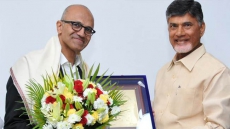A glorious musical tradition turned 140 on Monday and continues to hold on its own in an era of rock, rap, pop and fusion music.
The 'Harivallabh Sangeet Sammelan', which is the country's oldest musical festival, sees musical and vocal notes reverberate every year during chilly December evenings.
Aficionados of classical music from across the country assemble at the Devi Talaab temple area of Punjab's Jalandhar city, 160 km from Chandigarh, to be part of the famous classical music tradition.
"For us, this is a tradition which has to be kept alive. The format of the sammelan is such that new and upcoming artists are encouraged to perform along with the famous names of the country's classical music field. We don't want the old artistes to be forgotten and give a platform to new ones too," S.S. Ajimal, Director of the Harivallabh Sangeet Mahasabha told IANS.
The importance of the sammelan is such that the Indian government of India has recognized it as one of the National Festivals of Music.
The festival is organized in the last weekend of December every year at the sacred seat of music, the Samadhi of Baba Harivallabh - a saint and an exponent of Hindustani classical music.
Held for the first time 1875 at the sacred samadhi situated at Shri Devi Talaab in Jalandhar, the classical music tradition has not been broken.
Nearly all big names of Indian classical music scene have been associated with the Harivallabh festival over the years. These include Hari Prasad Chaurasia (flute), Bhim Sen Joshi (vocals), Pandit Jasraj (vocals), Ustad Bade Ghulam Ali Khan (vocals), Vishwa Mohan Bhatt (Mohan Veena), Ustad Allah Rakha Khan and Ustad Zakir Hussain (both tabla), Ustad Sultan Khan (israj), Gangubai Hangal (vocals), Pandit Ravi Shankar (sitar) and many more.
Prominent artists of Hindustani classical music from India and Pakistan have come and performed at the festival over the years.
Mahatma Gandhi, accompanied by Pandit Vishnu Digamber, visited the Baba Harivallabh Sangeet Sammelan in 1919.
Flute maestro Hari Prasad Chaurasia performed at the festival this year too. A star attraction this time was the 'jugalbandi' of traditional Indian music instrument 'Satvik Veena' (Pandit Salil Bhatt) with the western guitar (Matthais Muller) and 'Tabla' (Himanshu Bhatt).
"The performance begins later in the afternoon (2-4 pm) and continues till early morning (2-4 am). People come here from all over the country and even abroad. Attendance of the local residents is just 3-4 per cent," Ajimal pointed out while ruing the fact that classical music tradition hardly enthuses anyone in Punjab.
The Mahasabha, which has been organising the annual event over the years, says that it has to face budget constraints in keeping the tradition alive.
"Some of the famous artistes demand high fee for coming here to perform. We have to manage things within our Rs 35 lakh budget," Ajimal pointed out.
Entry to the Harivallabh Sangeet Sammelan is free. This time, the organisers installed a huge TV screen so that the audience could see the performing artists closely. The festival attracts up to 40,000 people during the three-day annual event.
"Drawing inspiration from Saint-musician - Baba Harivallabh, who started this Sangeet Sammelan in the memory of his Guru Swami Tulja Giri Ji, the Sangeet Sammelan has provided a platform where distinguished musicians could perform and give the best of their art and where anyone interested - initiated and uninitiated alike, could listen to them, free," the Harivallabh sammelan website states.
"In the olden times, no invitation cards used to be printed. December 26-29 used to be the dates fixed for the sammelan. The artists, the music lovers, the donors, everybody knew about these dates. These dates were published even in the 'Panchang' under the heading -Important Festivals of Northen India."
Till 1929, only vocal artists attended the sammelan. "Vichitter Veena was introduced in the Harivallabh stage by Mian Abdul Aziz of Patiala Gharana, Sitar by Ravi Shankar, sarod by Amjad Khan and flute by Shri Panna Lal Ghosh," the website says.






